
Sign up for daily news updates from CleanTechnica on email. Or follow us on Google News!
Portable energy storage systems have improved massively in the past few years. As electric cars have become much more popular, battery production has ramped up enormously, and thanks to economies of scale, battery prices have come down. The benefits of that extend well beyond the electric car market, also bringing down costs for electric bikes and portable battery storage systems, for example. The latest portable battery storage systems I’ve had the pleasure of testing out is the Yoshino B4000 Power Station* — and I absolutely love it.
The core point is that it does its job, and does it well. However, what stands out to me is its style or design. It looks elegant, stylish. You can stick it in your living room and it fits in nicely, attractively — not like a large computer hard drive out of place. Is this the most important thing in the world? No, but aesthetics and little things like this that make us like one item more than another make more of a difference than we probably acknowledge. Why do we buy art we find attractive, sofas and chairs we like the looks of, cars that appeal to our aesthetic taste?
Everything about the Yoshino system, including its supplementary solar panels, is especially well designed from an aesthetics point of view. I think the rest of the system was designed in an intelligent way with good attention to detail as well.
Overall, I think the Yoshino B4000 Power Station is a perfect size, with perfect specs for a lot of circumstances. I’ll come back to why in a moment, but let’s start with some key specs & stats on this device:
-
- 2611Wh energy storage capacity
- 4000W power output capacity
- 53.6 lb
- 80% charging in just ~70 minutes (using normal AC outlet)
- 4000+ cycles to 80% capacity
- 5-year warranty (top in the industry)
- $2,299
- $2,848 with one 200W solar panel array
- $3,599 with three 200W solar panel arrays (will review these later in the article)
Let’s also look at what it can power for how long, since that’s really what it’s about:
Here’s a bit more on the ports on the power station and the components included:
One notable aspect of the Yoshino storage system is that it uses solid-state batteries. “There are some debates out there regarding the technical definition of ‘solid-state.’ Yoshino aligns with the definition that major players like Samsung are using: Solid-state batteries use a solid electrolyte in place of the liquid or gel electrolyte found in traditional lithium batteries,” the company notes.
But what does this mean practically speaking, what does it matter? The key here is that these batteries are smaller and lighter than conventional batteries when providing the same amount of energy capacity and power capacity. Or, on the flip side, you can say that you can pack more electricity into a battery of the same size.
Also, solid-state batteries are safer than conventional lithium-ion batteries — they are less prone to catching on fire.
They also have a longer lifespan, Yoshino notes — they “can be charged and used over 4000 cycles, versus 500 for traditional batteries.”
These are all reasons why people have been excited about the prospect of solid-state batteries for electric vehicles. We’re not there yet, but reportedly getting closer. In the meantime, though, it’s nice to see some solid-state battery technology is making its way into stationary storage batteries. In this case, the battery tech is coming from Japan (hence the Japanese name), but the storage system was designed in California, where the company is headquartered.
Discount Season!
Also noteworthy: there are discounts running on this and other Yoshino products right now. You can get up to 34% off of Yoshino products between December 10 and December 22, 2024 (the discounts end at midnight on December 23). The theme is “Celebrate a Powered Christmas.” Here are pricing and discount details:
Now, on to our use and further review of the top-tier system.
Getting through a Hurricane without Power
First of all, my sister and her boyfriend used the system during Hurricane Milton. They lost power for a couple of days, and the Yoshino B4000 Power Station was a huge help in keeping their food refrigerated and the electronics charged up. Here are some key notes she provided me on their experience:
- At fully charged, it powered fridge for 12 hours.
- Appreciated the amount of power for the size. While a bit heavy for me, was able to carry it enough to take somewhere else for charging*. It also doesn’t take up much storage space. (*After the hurricane passed, but they were still without electricity, she was able to take it to her co-working space, which did have electricity, to charge it up.)
- Took about an hour to fully charge. Considering the convenience and that it kept our food good for 2 days, on 2 charges, would highly recommend.
- Tried to connect app for the always on option, that should be more obvious that you need the app for this, didn’t find out until using it.
- App would not connect — followed all directions and it kept saying no devices found (right next to it).
- Took a while to figure out there was a button we needed to press to start the charging. Directions could be better, considering the device is actually very easy to use once you know how.
I had the same issue that it took me a little while to find out that I had to press the little AC button to charge anything on AC and press the DC button to charge anything on DC. I also found that the size of the portable power station is close to ideal — or, maybe better said, ideal for several use cases. There’s always a tradeoff between size and energy storage capacity. What I love about the Yoshino B4000 Power Station is it’s just barely not too heavy to move from place to place. You have to be sure to do safe lifting to protect your back, but it’s actually a power station you can put in your trunk and take somewhere to charge, unlike a different system I have that has about twice the energy storage capacity but is too heavy to transport like that.
Personally, I love the design of this station. It is elegant, subtle, and quite aesthetically attractive. It looks great sitting in the living room next to the coach, unlike many portable power stations that look like super large computer hard drives or industrial machines. And the size is part of that. It’s not too bulky or too heavy.
Planning for a Future Hurricane with a More Elaborate Setup
I did various testing of normal devices at my house, but the really useful testing I did was when I took it to a neighbor’s house for deeper testing. I had never met this neighbor before, but he saw me charging the Yoshino power station with solar panels and started talking to me about it because he had been planning to get one (from a different brand). I showed him everything I loved about the Yoshino product and he asked if I could take it over to his house to test out some things. What a great idea that ended up being!
He had been an engineer (is now retired) and had set up an option in his garage to switch off the gird electricity and power the house with an off-grid power source. He has a generator that can plug in there, but he’s more interested in using a clean, quiet battery storage system now. The questions were: Will the Yoshino B4000 Power Station work for this? Will it power their refrigerator, lights, etc.? If so, for how long? Indeed — it worked! We plugged the house into the power station, and also even plugged in a small portable air conditioning system and a drill. It all worked! Also, it surprised us in how long it seemed the power station could power all of those things.
Powering the full size fridge, lights, the portable air conditioner, and some other things in the house, we were using about 3% of the battery every 20 minutes, or about 9% in an hour. Turning on the coffeemaker jacked up the power output real fast and sucked energy out of the battery more quickly. In this neighbor’s case, he would use the portable power system to power the refrigerator, probably the portable AC unit (depending on the weather), some lights, and phones as needed. They’d probably avoid using the coffeemaker. However, he also has a traditional fossil fuel generator. So, as needed, his plan would be to power those things until the battery was low and then recharge the battery with the generator, in order to use the noisy, stinky, expensive (fossil fuel is much more expensive) generator as little as possible. And, yes, he also loved the Yoshino device and now very interested in getting this model. He agreed it’s probably an ideal size — balancing weight and portability with energy storage capacity and power capacity.
Charging the Yoshino B4000 Power Station with Solar Panels
I got three solar panels to go along with the Yoshino B4000 Power Station in order to test those out too as an off-grid option for recharging the power station. With a similar system I had from another company, I struggled to get portable solar panels to charge the super large battery. In this case, though, the portable solar panels from Yoshino worked very well putting electricity back into the power station. That said, this isn’t the quickest way to do that, there are notable challenges to watch out for, and you probably need ideal conditions to not struggle with this recharging approach.
I’m going to go through the process of using the solar panels one step at a time using pictures. There’s also a video down at the bottom.
So, to start, the Yoshino SP200 solar panels come in nifty little boxes, with handles and all. Good design even starting with the packaging.
After unpacking them, you can see the outside of the folded up solar panels is a really sleek material that looks like suit material or fancy briefcase material. It looks really nice. There are also clever, easy-to-use little buttons on the sides for keeping them closed or opening them up.
This cable above comes with the B4000 Power Station. It connects to the cable that comes with each solar panel.
As you can see, the solar panel portion is tucked away nicely in a pocket on the front of the solar panel case.
Once you stand up the solar panel, the cable extends out the back to the power station.
You plug the cable that comes with the power station into the little yellow port seen in the first picture above. In the second picture, you can see it plugged in. It’s all very easy to do once you know what you’re doing, of course.
If you use two solar panels, one of those connectors from the station’s cable connects to one panel and the other connector connects to the other solar panel. (Yes, that leaves one connector from each of the solar panels doing nothing.) Using three solar panels is more complicated and comes with one issue — I’ll come to that in a moment, but it’s really explained better in the video.
Using three solar panels, you again connect the cable from the power station to two solar panels. The third solar panel then connects to each of those remaining connectors from the other two solar panels. See the graphic above for easier visual explanation and understanding.
The problem is that the cables aren’t very long, and connecting all three solar panels was difficult, particularly in the late afternoon sun. As a result, the solar panel array in the middle was shaded, which cuts electricity generation pretty significantly. In the pictures above, the cables connecting the first solar panel array and the third one were extended as far as possible.
You can buy extra connector cables that allow you to spread them out further. I’d recommend doing that.
The good news is the solar panels do work and add electricity to the energy storage system. In the picture above, one solar panel was connected and was providing 145 watts at that moment. Yoshino writes that “it takes just 4.5 hours of sunlight to reach 80% capacity with three SP200 solar panels (600W Input).” However, you have to be in ideal conditions to meet those numbers. Don’t expect to get close to those numbers with any shading or when the sun isn’t shining fully onto the solar panels.
Nonetheless, I was happy to see that this worked, that the system didn’t use so much energy cooling itself that it wasn’t gaining stored electricity. In fact, this is a key selling point of this system.
B4000 Power Station Summary
Overall, I absolutely love the B4000 Power Station. It’s an ideal size when it comes to balancing portability, energy storage capacity, and power capacity. It’s efficient and has every outlet I could want. It’s sleek and attractive, even with regard to colors and the storage cases around the solar panels. Do I love the B4000 Power Station? yes, I do.
As far as pricing, it’s currently $2,299, on a deep discount down from $3,299. If you add in the three solar panels, the price is $3,599, down from $4,749.
* Note: This article was sponsored by Yoshino, but my opinions and experience here are 100% genuine and honest.

Chip in a few dollars a month to help support independent cleantech coverage that helps to accelerate the cleantech revolution!
Have a tip for CleanTechnica? Want to advertise? Want to suggest a guest for our CleanTech Talk podcast? Contact us here.
Sign up for our daily newsletter for 15 new cleantech stories a day. Or sign up for our weekly one if daily is too frequent.
CleanTechnica uses affiliate links. See our policy here.
CleanTechnica’s Comment Policy





























